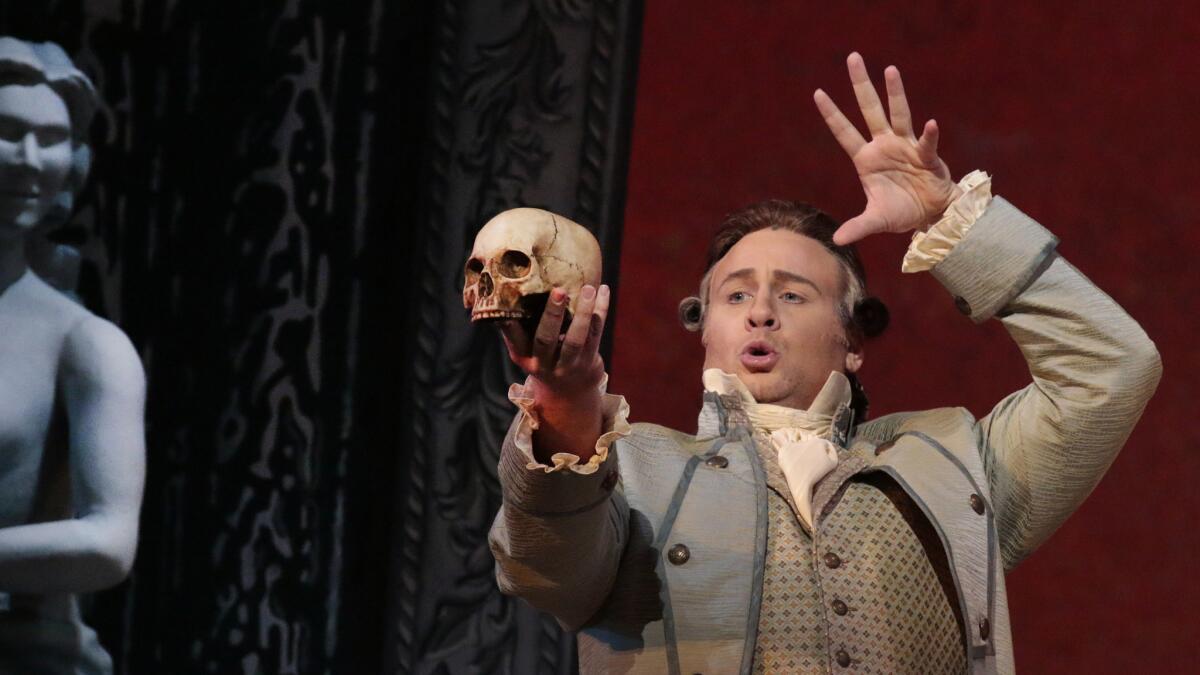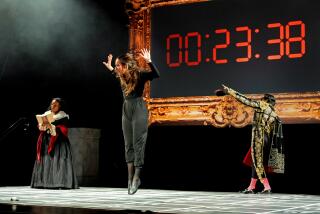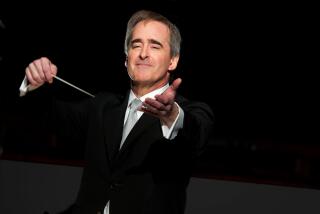Critic’s Notebook: The world as seen by Beaumarchais through a character named Figaro

Whether Rolex, the official timepiece of Los Angeles Opera, knows it not, it is as much a beneficiary of the work of Pierre-Augustin Caron de Beaumarchais as the opera company itself. The 18th century French playwright wrote the trilogy of plays around which the L.A. Opera’s ongoing “Figaro Unbound” festival is based.
The son of a watchmaker, Beaumarchais invented an escapement for pocket watches and did other things as well. He was musician, composer, lyricist, singer, actor, poet, publisher, courtier, swordsman, spy, diplomat, shipping magnate, philanthropist and horticulturist. He served French kings in Versailles, spent time in jail for insubordination to a duke and provided aid to both the French and American revolutions.
Were he a character in opera, he would not be found believable. But the presence of this protean, Figaro-ean figure is all over the place once you start looking, in avant-garde new operas still in development presented by the Industry last weekend or in the Charlie Hebdo tragedy in Paris.
“Figaro Unbound” is a loose collection of activities offered by local universities, art museums and performing arts groups initiated by L.A. Opera to provide context and relevance and whimsy to opera. In this case, it is L.A. Opera’s productions of three operas based on Beaumarchais’ “Figaro” trilogy: Rossini’s “Barber of Seville” opening Saturday, Mozart’s “Marriage of Figaro” opening March 21 and John Corigliano’s “The Ghosts of Versailles.”
Corigliano’s “Ghosts,” which is having its most notable revival since its Metropolitan Opera premiere almost a quarter century ago and has a final L.A. Opera performance on Sunday, is not, on the one hand, a Beaumarchais opera, since it takes only its impetus from “The Guilty Mother,” the final and least-known play in the Figaro trilogy. On the other hand, it is a Beaumarchais opera in that the playwright is a central character.
In a discussion with Conlon at a festival event at the Hammer Museum, Corigliano repeated an assertion that he’s made many times, that “The Guilty Mother” is not a very good play. He parodies the play by having Beaumarchais stage it in heaven for the other ghosts of Louis XVI’s court, including the king’s wife, Marie Antoinette.
Beaumarchais’ plays are social satire on class and capture the spirit of revolution that had overtaken the French zeitgeist. Through entertaining guile, Figaro, a Spanish count’s valet, helps his master outwit a doddering doctor to marry his beautiful ward. But the count’s eye continues to wander and, in “The Marriage of Figaro,” ever more elaborate schemes are needed to keep the count’s hands off Figaro’s new bride. Through Mozart’s music, we feel we witness the maturation process as the count and his household look inside themselves.
But for Beaumarchais these lessons didn’t take. Cynicism and bitterness trickled down to even Figaro. The schemes take on a nastier turn. Goodness does prevail in the end, but with the wary understanding that innocence once lost can never be replaced.
French audiences clearly enjoyed seeing nobility mocked and recognized Figaro as a potent symbol for rebellion. In the history of French satire from Voltaire to Charlie Hebdo, Beaumarchais is a key figure.
But compared with Charlie Hebdo cartoonists who paint with a broad brush to directly provoke, Beaumarchais meant to instruct through entertainment. He set the plays in Spain so as not to specifically offend the court in Versailles, not that everyone in France didn’t see through that, including an annoyed Louis XVI.
Among the “Figaro Unbound” events this month at UCLA have been a radio-style reading by L.A. Theater Works of “The Guilty Mother” and a staging by Opera UCLA of Saverio Mercadante’s “The Two Figaros,” an obscure early 19th century Italian opera discovered just six years ago. Each in its own way revealed the importance of Beaumarchais.
“The Guilty Mother,” written in 1791, turns out to be a searing drama, more dark than amusing. It ends with a happy couple able to marry thanks to Figaro exposing a villainous manipulator, but given all that has gone wrong with both the count’s and Figaro’s marriages, it is a bittersweet ending, mirroring the French Revolution’s loss of idealism that was beginning to take place at the time.
“The Two Figaros,” written in 1835, is one of many attempts by others to capitalize on Beaumarchais. It is an elaborate, ludicrous sequel to “Marriage of Figaro” with capable music in the style of Rossini. It’s a lot of unmemorable fun, done with flair by student performers. But it has no bite, no relevance to its or our time. History forgot it for a reason.
Beaumarchais’ work, on the other hand, continues to matter. “Figaro Unbound” began last month with “Figaro (90210),” an updated performance of Mozart’s opera by engaging young performers. The libretto was wittily yet pointed rewritten by Vid Guerrerio to reflect the plight of undocumented immigrants in a way that really was in the spirit of Beaumarchais.
If you find yourself at the Norton Simon Museum, pick up L.A. Opera Music Director James Conlon’s audio tour in which he relates 14 paintings from the permanent collection to the Figaro operas. I was sorry to have missed a discussion of women and law as seen through the operas at the Huntington Library earlier this month. LACMA is currently highlighting painting and sculpture related to the French Revolution in tribute to Beaumarchais; MOCA next month will connect revolutionary modern art to “Figaro Unbound.”
Still, the most striking examples of what Beaumarchais has wrought remains in opera. At the Industry’s “First Take,” with previews of six operas-in-progress, Paul Pinto’s “Unintelligible Response” was a very modern, satirical yet serious Beaumarchais-like take on Thomas Paine, who inspired Beaumarchais’ own revolutionary fervor.
In another, Anne LeBaron’s “LSD: The Opera,” the drug is personified as an opera character by three singers with whom LSD’s discoverer, Albert Hofmann, interacts. That same magical realism occurs in “The Ghosts of Versailles,” where Beaumarchais steps into his own play to tell Figaro what to do.
This kind of fanciful operatic device may seem to go against everything Beaumarchais stood for. It was he who brought opera up to date, removing it from myth and history. There is no way we can imagine what opera today would have been like without him. The silliness and sentimentality in “Ghosts” can seem, at points, anti-Beaumarchais, yet the playwright is the most complex and touching character in the opera.
Who Beaumarchais was and what he stood for cannot be ignored. A man of the world, he made the masses laugh and then turned their laughter into unsentimental social activism rather than, as too many satirists do today, simply make people mad.
Twitter: @markswed
More to Read
The biggest entertainment stories
Get our big stories about Hollywood, film, television, music, arts, culture and more right in your inbox as soon as they publish.
You may occasionally receive promotional content from the Los Angeles Times.







